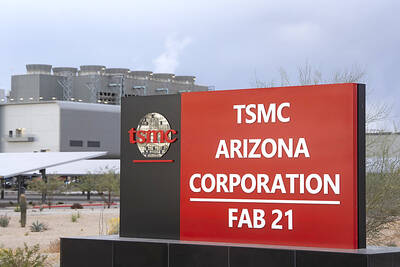For Sara Velazquez and her husband, purchasing the 22 acres behind their rural Pennsylvania home was the start of a lengthy effort to preserve and resuscitate the hilly forestland.
The question was how to pay for that work.
“A nice, healthy oak forest — that’s what I want,” Velazquez, 28, told the Thomson Reuters Foundation in June, sweeping her arm across the property’s shadowed valleys and mixed tree stands.

Photo: Reuters
“We have a lot of invasive species in here, so dealing with that is part of our plan over time,” said her husband, Dan Nelson, 37.
However, just after they purchased the land in 2019, the COVID-19 pandemic forced them both out of work, raising concerns about how to pay the annual taxes on the land.
One option could be logging, a common priority in the region, Nelson said.
“It’s sort of the culture here. When we bought the property, everyone was like, ‘Are you going to log it?’” he said, adding that many see timber as “free money up in the woods.”
Now they think they have found a different solution.
In December last year, the couple signed a 20-year contract with the nonprofit American Forest Foundation’s Family Forest Carbon Program, which aims to help small-scale landowners with as little as 12 hectares do something new: access fast-growing “carbon markets.”
The trees on Velazquez and Nelson’s properties are to absorb and store a measured amount of carbon for at least the next two decades.
Credits for that effective reduction in climate-changing emissions are, in turn, sold to help corporations such as outdoor outfitter REI move toward their “net zero” emissions goals.
To achieve the goals, companies are supposed to reduce their own emissions to nearly zero, but can buy emissions reductions elsewhere — known as “offsets” — to cover any remaining hard-to-cut pollution.
Velazquez and Nelson, in turn, receive cash that helps them cover their tax payments, plan for revitalizing the forest and, for now, stay away from logging.
In the US, the largest portion of forest land — 39 percent — is family owned, in addition to that owned by the government, timber companies and other entities, American Forest Foundation said.
As such there has long been promise in connecting small-scale landowners with carbon markets, said David Wear, a senior fellow at the Washington-based Resources for the Future think tank.
However, there has also been a question of how to do so, given upfront costs of up to US$200,000 for project development, monitoring and more, as well as the 100-year contracts typically involved.
“Now we’re at a juncture,” Wear said of new efforts bridging this gap.
“This is the emergence of something like agricultural coops: You don’t have the ability to market directly to your purchaser as an individual, but you can come together and engage the marketplace as an aggregate,” he said.
Such efforts are now set for a major boost under climate legislation passed this week by the US Senate, which would provide US$450 million to push private landowners toward forest management practices with climate benefits, nonprofit American Forests said.
The bill includes a particular focus on underserved communities and family forest owners, and would likely bolster programs such as the Family Forest Carbon Program.
If passed by the US House of Representatives, the legislation would “unlock the power in family-owned forests to tackle climate change,” American Forest Foundation president Rita Hite said in a statement.
LOGGING ALTERNATIVE
For small landowners, these new programs seek to help tip the scales on the value of forests, making standing trees more valuable than harvested timber, and in turn guiding new management practices.
“The majority of landowners don’t actually say their number one interest is in timber, but the majority do end up timbering their land,” said Sarah Hall-Bagdonas, senior forestry manager for the Family Forest Carbon Program, which launched in 2020 and also helps landowners come up with a sustainable forest management plan.
“So the voluntary carbon market really provides them with another option besides the timber market,” she said.
The voluntary carbon market more than doubled from 2020 to last year to more than US$1 billion, the Ecosystem Marketplace research group said.
That growth might make it seem “as if there’s conflict between managing for carbon and managing for timber,” as landowners increasingly opt for carbon, American Forest Foundation senior vice president Nathan Truitt said.
However, the two are not exclusive, he said.
“Rather than thinking about harvest versus not harvest, good projects will think about how you adjust harvesting so you maximize productivity of the land ... to create more carbon and more timber,” Truitt said.
As yet, the financial incentive for storing carbon is not enough to prompt harvest reductions, said Jim Hourdequin, chief executive officer and managing director of the Lyme Timber Co, which manages about 607,000 hectares of forest.
For that to begin to happen, “the price needs to be a lot more than the current price of carbon,” he said — about US$27 to US$55 per tonne, or two to three times today’s price.
DEFRAYING COSTS
At the other end of Pennsylvania from Wayne County, Raul Chiesa and Janet Sredy own and manage Beckets Run Woodlands — 45 hectares that has been in Sredy’s family but long saw poor agricultural and management practices, she said.
Since 2007, the couple has been working to resuscitate the land’s forests, manage for wildlife and safeguard rare plant species such as snow trillium, which blooms when snow still covers the ground.
The work costs about US$10,000 a year, defrayed through grants, timber harvesting, hunting leases and other earners — now including carbon sequestration.
Chiesa and Sredy are working with a company called NCX, which uses satellite imagery and artificial intelligence to gauge carbon-storage potential on small land holdings. It then sells carbon credits, with the income going to help landowners defer logging for a year at a time.
Since last year, the company has enrolled nearly 2,500 US landowners who hold more than 1.6 million hectares, with a median size of about 80 to 160 hectares per landowner, it said.
“If our societal goal is to mitigate climate change and enable climate storage on land rather than in the atmosphere ... we’ll need to enable all of the landowners to participate in the carbon market,” NCX chief sustainability officer Jennifer Jenkins said.
Lengthy sequestration contracts can be obstacles to small landowners participating in carbon storage efforts, but shorter contracts can help drive immediate action to protect forests, she said.
“It’s too late if we wait 99 years,” said Jenkins, adding that NCX hopes to extend its year-long contracts to two to five years.
However, critics question the approach’s impact on the climate.
Chiesa and Sredy, who started thinking about carbon sequestration a decade ago, signed with NCX in January, and in December they should receive a little more than US$1,400.
They can then re-enroll, although first they plan to compare timber and carbon prices.
For now, the process has deepened their appreciation of the property’s trees — and Chiesa said carbon credits feel like a real opportunity.
“This is the business of conservation that is being sustained, supported by a different type of economy ... other than conventional forest products. This is something that’s absolutely new,” he said.

JITTERS: Nexperia has a 20 percent market share for chips powering simpler features such as window controls, and changing supply chains could take years European carmakers are looking into ways to scratch components made with parts from China, spooked by deepening geopolitical spats playing out through chipmaker Nexperia BV and Beijing’s export controls on rare earths. To protect operations from trade ructions, several automakers are pushing major suppliers to find permanent alternatives to Chinese semiconductors, people familiar with the matter said. The industry is considering broader changes to its supply chain to adapt to shifting geopolitics, Europe’s main suppliers lobby CLEPA head Matthias Zink said. “We had some indications already — questions like: ‘How can you supply me without this dependency on China?’” Zink, who also

Taiwan Semiconductor Manufacturing Co (TSMC, 台積電) received about NT$147 billion (US$4.71 billion) in subsidies from the US, Japanese, German and Chinese governments over the past two years for its global expansion. Financial data compiled by the world’s largest contract chipmaker showed the company secured NT$4.77 billion in subsidies from the governments in the third quarter, bringing the total for the first three quarters of the year to about NT$71.9 billion. Along with the NT$75.16 billion in financial aid TSMC received last year, the chipmaker obtained NT$147 billion in subsidies in almost two years, the data showed. The subsidies received by its subsidiaries —

At least US$50 million for the freedom of an Emirati sheikh: That is the king’s ransom paid two weeks ago to militants linked to al-Qaeda who are pushing to topple the Malian government and impose Islamic law. Alongside a crippling fuel blockade, the Group for the Support of Islam and Muslims (JNIM) has made kidnapping wealthy foreigners for a ransom a pillar of its strategy of “economic jihad.” Its goal: Oust the junta, which has struggled to contain Mali’s decade-long insurgency since taking power following back-to-back coups in 2020 and 2021, by scaring away investors and paralyzing the west African country’s economy.

RE100 INITIATIVE: Exporters need sufficient supplies of renewable energy to meet their global commitments and remain competitive, the economics ministry said Local export-oriented manufacturers, including Taiwan Semiconductor Manufacturing Co (台積電), require sufficient supplies of green energy to maintain their competitiveness and regulations already ensure that renewable energy development adheres to environmental protection principles, the Ministry of Economic Affairs said yesterday, as the legislature imposed further restrictions on solar panel installations. The opposition-led Legislative Yuan yesterday passed third readings to proposed amendments to three acts — the Environmental Impact Assessment Act (環境影響評估法), the Act for the Development of Tourism (發展觀光條例) and the Geology Act (地質法) — which would largely prohibit the construction of solar panels in some areas. The amendments stipulate that ground-mounted solar